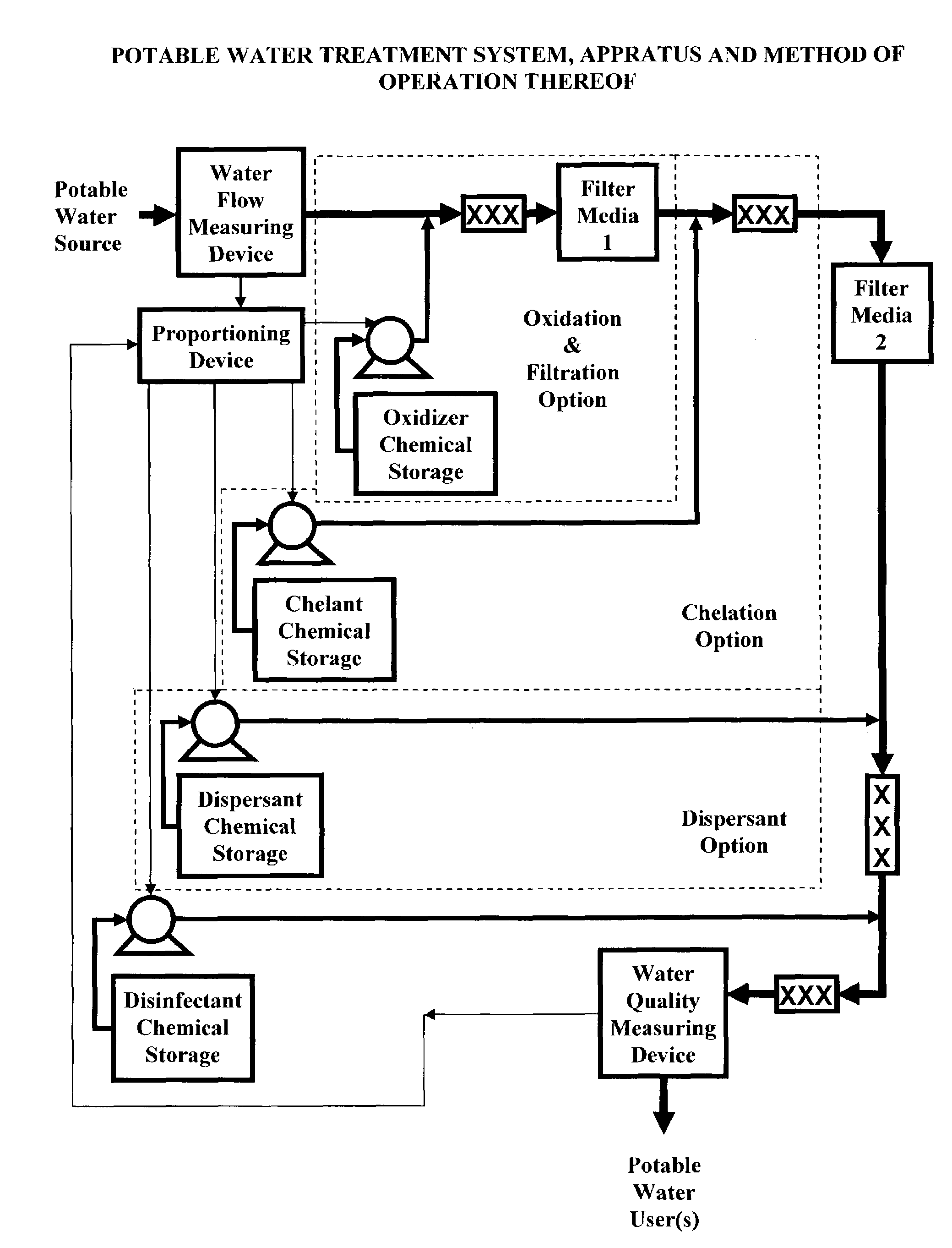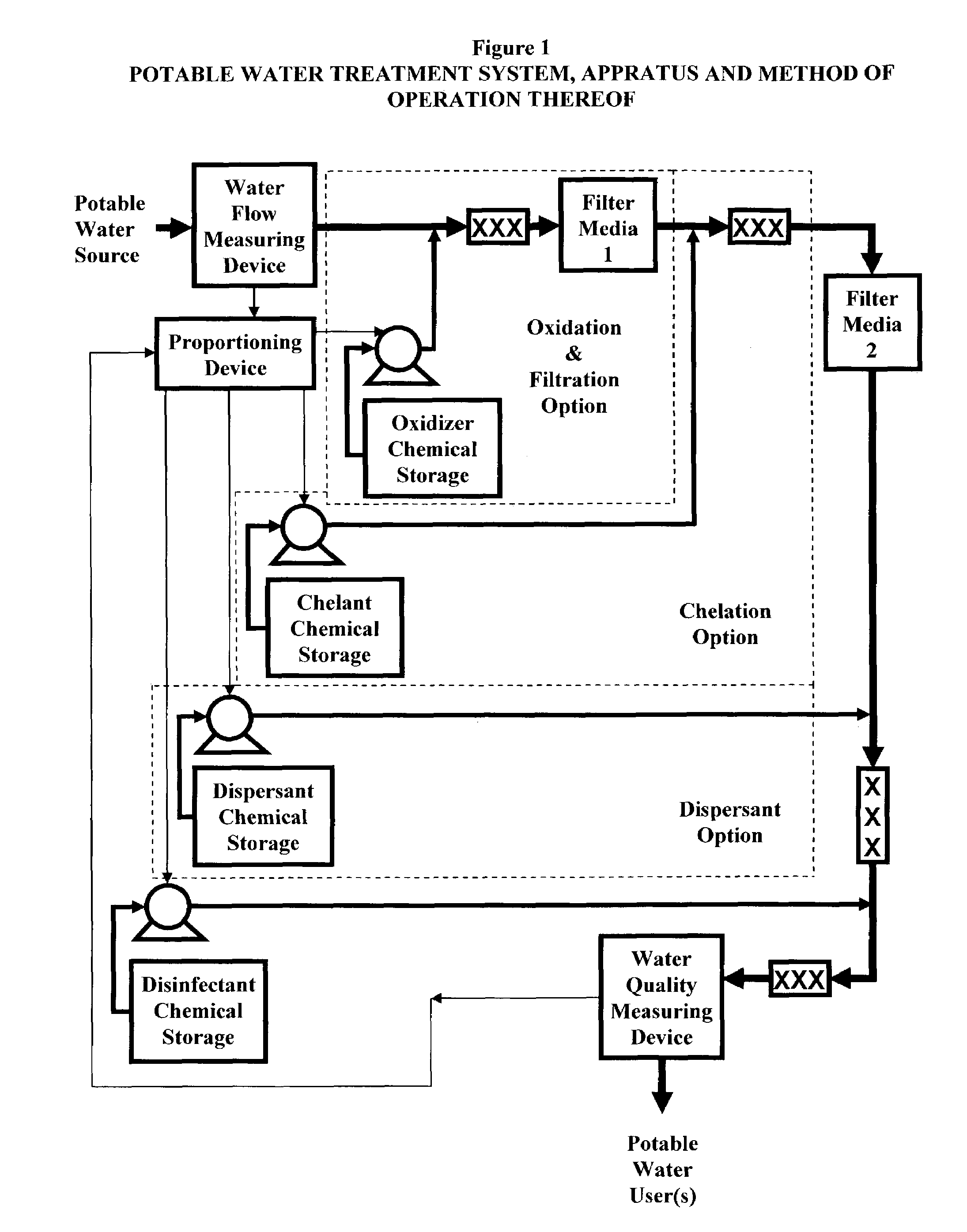A major issue with which potable water consumers (including, but not limited to residential, office, public and commercial buildings) have been faced is the ability to control at least one of: taste,
odor,
turbidity, bacterial and / or
viral contamination, heavy
metal contamination,
hardness, mineral deposits and / or a combination of these
water quality parameters form potable water sources.
In low
hardness, soft, potable waters, the water is often acidic causing the
corrosion of
metal materials thereby placing soluble metal ions in the water, which are dangerous to health and reduce the life of metal materials.
Distillation is very energy intensive; and, very pure water from
distillation is not good for
human health as water which is too low in mineral content will literally remove minerals from the
human body into the bloodstream as the body absorbs the water.
Lime softening plants are very expensive to build and to operate; therefore, these plants are not installed as often as needed.
High amounts of
alkalinity will also
attack the fibers in clothes during washing.
While effective, these systems are costly, require regular replacement and remove
calcium and / or
magnesium from the water to the point of the water not being good for
human health, similar to
distillation.
Scale deposits can localize
corrosion causing water lines and equipment to leak.
Scale deposits often result in equipment replacement, such as water heaters, tile, glassware,
piping, etc.
Sludge deposits are not such a challenge;
sludge deposits, though, are unsightly to the homeowner or potable water user.
In any event, often
surface water treatment does not adequately and effectively remove solids, as well as adequately remove
solid forming or scale forming impurities from the water.
Further, use of the low molecular weight acid variants may lead to
corrosion on metal surfaces and in high concentrations and / or at high temperatures (normally above 130° F.) all of these inhibitors can lead to the formation of phosphate and / or
chloride salt scale, wherein the cation may be at least one of:
calcium, magnesium, silica and / or a combination thereof.
However, these chemicals have had sparing use in potable water treatment and have only been applied at the
surface water treatment facility or in combination with membranes to limit
membrane fouling, if used at all.
Further, the use of phosphate inhibitor
chemistry is infrequent in potable water.
However, the goals of municipalities and the goals of potable water users are rather incongruent.
In particular,
Cryptosporidium is the contaminant that made thousands sick in Milwaukee causing The U.S. EPA to re-evaluate the drinking water standards.
For the elderly, infants and / or those with weakened immune systems, infection can be fatal, as occurred to dozens in Milwaukee.
Disinfection byproducts are carcinogenic and / or teratogenic, as well as toxic.
However, these devices have another feature; these devices do nothing to control mineral or metal salt deposition.
Methods of application of such systems and devices can be relatively complex and costly and require very careful control.
The Persinski patent presents chemical combinations which prevent scale and corrosion; however, the Persinski patent does not address potable water, drinking water, the
filtration of potable water, the addition of disinfectants or an apparatus or a method of addition of a at least one of: chelants, dispersants and disinfectants to potable water.
More specifically, Persinski does not at all address the importance of removing solids or metals from the water.
. . ” As soluble compounds, metals are much more difficult to remove by
filtration; therefore, under a worst case
scenario Persinski presents technology which would be toxic in applications wherein heavy metal(s) are present in the drinking water.
Under a best case
scenario, Persinski presents technology which in drinking water would lead to the disinfectant oxidizing the soluble metal(s), which would lead to taste issues.
In any event, Persinski presents a technology wherein the metals could not be removed or would be very difficult to remove.
While Martin discloses an apparatus to control a coagulant dosage, thereby controlling water
turbidity, Martin does not address water scale, filtration or the addition of either a chelant, dispersant or a disinfectant.
Lastly, Martin does not discuss the treatment of potable water.
While White discloses a novel filter media combination, White does not describe a method for controlling scale of
sludge deposits in potable water.
Most significantly, White does not disclose a method for adding a disinfectant to the water after filtration; the While filtration design leaves the water susceptible to bacterial and
viral contamination after filtration.
The only method around such a
contamination issue with White would be to leave enough metallic cations in the water after filtration to eliminate biological or
viral growth; such a design would leave the water outside of the
heavy metals requirements as set forth by the U.S. EPA and / or NSF International, as such the water would be toxic and not be fit for human consumption.
Further, White does not disclose an apparatus or method of
chemical addition to potable drinking water.
While it is obvious that
Ray is the closest prior art to the invention,
Ray does not provide a system of treatment that would be applicable to potable, drinking, water.
This method is not viable in drinking water, as the filter if at all capable of removing organics will also remove the oxidant or disinfectant, thereby leaving the water without a disinfectant and capable of
contamination with
bacteria and / or viruses downstream.
Santina does not teach or suggest a method of controlling scale deposits, removing
bacteria and viruses or adding a disinfectant.
 Login to View More
Login to View More 

